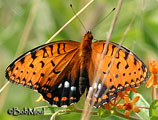Native Plants
Search for native plants by scientific name, common name or family. If you are not sure what you are looking for, try the Combination Search or our Recommended Species lists.
Viola pedata
Viola pedata L.
Birdfoot Violet, Bird's-foot Violet, Bird-foot Violet
Violaceae (Violet Family)
Synonym(s): Viola pedata var. concolor, Viola pedata var. lineariloba, Viola pedata var. ranunculifolia
USDA Symbol: VIPE
USDA Native Status: L48 (N), CAN (N)
Bird-foot Violet is a low, clumped perennial, 4-10+ in. high, with large, almost pansy-sized flowers. The leaves, almost round in outline, are 3/4-2 inches long, deeply cut into 3-5 segments, and these again narrowly lobed. The leaf stem is 4-6 inches long. Flowers are pale to dark purple, broad, flat, 1-1 1/2 inches across. They have 5 petals, the 2 upper ones smaller than the lower 3 and deep violet. The lowest petal has the dark streakings which are common to most violets. There are 5 stamens with brilliant orange anthers.
A most beautiful Violet of dry, upland sites. Its showy, light violet-blue flowers, distinctive "bird's-foot"-shaped leaves make it easy to identify. It is pollinated by bees and butterflies. The bicolored form of this species, with its 2 upper petals a deep violet and the lower 3 a lilac shade, has been considered the most beautiful Violet in the world. This violet does not reproduce vegetatively like most other violets. Reproduction is by seed only.
Plant Characteristics
Duration: PerennialHabit: Herb
Leaf Complexity: Simple
Fruit Type: Capsule
Size Notes: Up to about 1 foot tall.
Fruit: Green
Bloom Information
Bloom Color: White , Blue , Purple , VioletBloom Time: Mar , Apr , May , Jun
Distribution
USA: AL , AR , CT , DC , DE , GA , IA , IL , IN , KS , KY , LA , MA , MD , ME , MI , MN , MO , MS , NC , NE , NH , NJ , NY , OH , OK , PA , RI , SC , TN , TX , VA , WI , WVCanada: NB , ON
Native Distribution: MA to MN, s. to GA & e. TX
Native Habitat: Rocky, open woods; sandy prairies & pinelands
Growing Conditions
Light Requirement: Part Shade , ShadeSoil Moisture: Dry
Soil pH: Acidic (pH<6.8)
Soil Description: Dry, rocky, or sandy soils.
Conditions Comments: This plant is particularly susceptible to crown rot if drainage is not excellent.
Benefit
Conspicuous Flowers: yesAttracts: Birds , Butterflies
Butterflies and Moths of North America (BAMONA)
|
Regal Fritillary (Speyeria idalia)  Larval Host |
Propagation
Description: May be propagated by root cuttings taken in early spring or by seed. Seed can be planted immediately after collection or in the spring. Rootstock cuttings should be made lengthwise making sure each section has well-developed buds and roots.Seed Collection: Collect in the brief time after the seed turns from white to brown and before the capsules explode (usually mid-Jun). Store dried seed in sealed, refrigerated containers.
Seed Treatment: Cold-moist stratification for 10 days.
Commercially Avail: yes
Mr. Smarty Plants says
Small perennials & grasses for a naturalized lawn
October 26, 2009
I am looking for native perennials and grasses that will grow no more than 8 inches tall that can be used in a naturalized lawn in Michigan. What 5 plants would be your first choice?
view the full question and answer
National Wetland Indicator Status
| Region: | AGCP | AK | AW | CB | EMP | GP | HI | MW | NCNE | WMVE |
| Status: | FACU | FACU | UPL | UPL | UPL |
From the National Organizations Directory
According to the species list provided by Affiliate Organizations, this plant is on display at the following locations:Delaware Nature Society - Hockessin, DE
Mt. Cuba Center - Hockessin, DE
Bibliography
Bibref 1186 - Field Guide to Moths of Eastern North America (2005) Covell, C.V., Jr.Bibref 1185 - Field Guide to Western Butterflies (Peterson Field Guides) (1999) Opler, P.A. and A.B. Wright
Bibref 318 - Native Texas Plants: Landscaping Region by Region (2002) Wasowski, S. & A. Wasowski
Bibref 248 - Texas Wildflowers: A Field Guide (1984) Loughmiller, C. & L. Loughmiller
Bibref 328 - Wildflowers of Texas (2003) Ajilvsgi, Geyata.
Search More Titles in Bibliography
Web Reference
Webref 38 - Flora of North America (2019) Missouri Botanical Garden, St. Louis, MO & Harvard University Herbaria, Cambridge, MA.Webref 23 - Southwest Environmental Information Network (2009) SEINet - Arizona Chapter
Research Literature
Reslit 2873 - Viola pedata (2012) Kim BlaxlandThis information was provided by the Florida WIldflower Foundation.
Search More Titles in Research Literature
Additional resources
USDA: Find Viola pedata in USDA PlantsFNA: Find Viola pedata in the Flora of North America (if available)
Google: Search Google for Viola pedata
Metadata
Record Modified: 2023-01-03Research By: TWC Staff